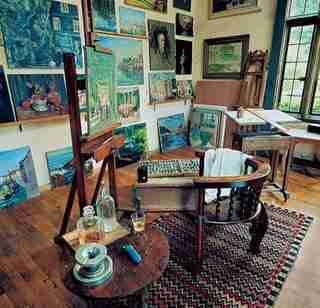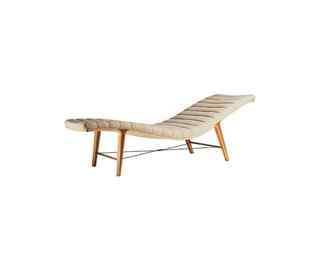1940’s Interior Design and Architecture

Winston Churchill
“A day away from Chartwell is a day wasted,” Sir Winston Churchill said of his country house in Kent. During World War II, his finest hour, the statesman closed up the house. His painting studio still contains his effects.

Edward Wormley
Although Wormley was an influential interior designer, he made his mark creating pieces for the Dunbar Furniture Company from 1931 to 1968, such as a 1948 daybed with laminated wood strips.

Philip Johnson
“It was always a good place to live, but it’s never been as beautiful as it is today. It’s more a symbol of a way of life than a symbol of architecture,” the architect said nine years ago of his 1949 Glass House , which sits on 40 acres in Connecticut.
Albert Frey
A pool that flowed into the living room was one element of industrial designer Raymond Loewy’s Palm Springs house, designed in 1947 by Frey, who spearheaded modernism’s move to the desert.
Elsie de Wolfe
“I can’t paint, I can’t write, I can’t sing,” said de Wolfe . “But I can decorate and run a house, and light it, and heat it, and have it like a living thing and so right it will be the envy of the world, the standard of perfect hospitality.”
Jean Royere
French 1940s furniture “is very graceful, more like sculpture,” says dealer Bruce Newman. Above: A table from Royere’s Tour Eiffel line has a latticework-and-ball motif.
Harold Grieve
“Group your furniture and ornaments artistically. Use color liberally,” counseled Grieve, a set designer and a founding member of both AMPAS and the ASID. Above: He gave Miriam Hopkin’s living room an Art Moderne style.
Eames Screen and Knorr Chair
Finely crafted furniture that could be mass-produced became the watchword among postwar designers. An Eames screen and a Don R. Knorr chair were created for Herman Miller and Knoll, respectively.
Charles Eames
“We have to throw all of our designs away. His designs are five years ahead of ours,” said George Nelson, then the head of Herman Miller, who saw Eames’s new chairs at an exhibit at MoMA in 1946.
Dorothy Draper
“Coming from a time when everything was itty-bitty, she thought big. She had a rare sense of scale. More than anything else, Dorothy Draper brought color into the home,” recalled designer Carleton Varney.